Origins of DJ Mixes
The world of DJ mixes has a fascinating history that reaches back to the earliest days of sound systems and vinyl records. In the 1970s, pioneers like Kool Herc and Grandmaster Flash began experimenting with turntables, manipulating records to extend beats and keep dancers moving on the floor. This creative act of blending two or more tracks seamlessly formed the backbone of what would later evolve into DJ culture. At its heart, DJ mixing is about control over rhythm, tempo, and transitions, turning pre-recorded music into a live and fluid experience.
Over time, DJs became more than selectors of tracks; they emerged as curators of mood and energy. By aligning beats and crafting smooth transitions, they created an entirely new way of listening to music that was both communal and deeply immersive. What began as an underground practice in block parties quickly became a global phenomenon. As clubs, raves, and festivals grew in popularity, Mixes dj transformed into an essential part of nightlife culture, allowing artists to build reputations based not only on song selection but also on their technical skill and creativity in weaving sounds together.
The Craft Behind the Mix
A well-crafted DJ mix is a performance of precision and artistry. Beatmatching, the fundamental technique of aligning the tempos of two tracks, remains at the core of DJing even as technology evolves. Yet beyond technical synchronization, DJs must possess a keen ear for harmonics, mood, and energy. Mixing is not just about transitioning from one track to another; it is about telling a story through sound, gradually building tension and releasing it in a way that keeps listeners engaged.
To achieve this, DJs often layer elements of different tracks, using equalizers, filters, and effects to create depth and variation. The selection of tracks is just as important as the mixing itself. Choosing songs that complement each other in rhythm, key, and energy level ensures that the set flows smoothly and captivates the audience. A skilled DJ knows how to read the crowd, adjusting the energy of the mix to match the moment—whether it requires a high-intensity drop that ignites the dance floor or a slower, atmospheric section that allows people to breathe and reflect.
Evolution Through Technology
The progression of DJ mixes has been shaped significantly by advancements in technology. In the vinyl era, DJs carried crates of records and mastered the art of manipulating physical media. With the advent of CDs and later digital formats, DJing became more accessible while also opening the door to new creative possibilities. Today, software such as Serato, Rekordbox, and Traktor, alongside hardware like controllers and digital turntables, allows DJs to explore endless variations in sound.
This technological shift has democratized DJing, enabling aspiring artists to experiment with mixing without needing extensive physical collections. At the same time, it has raised debates about authenticity and artistry, as some argue that automation reduces the skill involved. However, technology has also expanded the creative palette, giving DJs tools to remix tracks live, incorporate samples, and even integrate visuals with their sets. The evolution of DJ mixes illustrates how tradition and innovation can coexist, with new technologies amplifying rather than replacing the artistry at the core of mixing.
Cultural Influence of DJ Mixes
DJ mixes are not confined to clubs or festivals; they have seeped into popular culture and daily life in profound ways. Radio stations often rely on DJ mixes to provide continuous, engaging content for listeners, while streaming platforms host thousands of recorded sets from around the world. These mixes serve not only as entertainment but also as a way of discovering new music. For many fans, following a favorite DJ is a gateway to exploring underground genres, niche artists, and innovative sounds that might otherwise go unheard.
Moreover, DJ mixes have become synonymous with communal celebration. At music festivals, massive crowds are united by the shared experience of a DJ performance, creating a sense of connection that transcends language and culture. In everyday settings, mixes accompany workouts, study sessions, and personal relaxation, becoming a soundtrack to modern life. By bridging cultural divides and providing a universal language of rhythm and melody, DJ mixes embody the power of music as a force for unity and self-expression.
The Future Soundscape of DJing
Looking ahead, the landscape of DJ mixes promises to be even more dynamic and boundary-pushing. The rise of artificial intelligence, virtual reality, and immersive audio technologies suggests that the future of mixing will involve multi-sensory experiences. DJs may soon design sets that adapt in real time to the emotions of the audience or that integrate interactive visuals and spatial audio for a deeper level of immersion. At the same time, the growth of online streaming has already redefined the role of DJs, allowing them to reach global audiences instantly without being confined to physical venues.
Yet amidst this innovation, the essence of DJ mixes will remain rooted in human creativity and the instinct to connect through music. Technology may change the tools, but the emotional impact of a perfectly timed transition or a drop that electrifies a crowd will never lose its magic. The next generation of DJs will likely blend tradition with futuristic possibilities, crafting experiences that honor the past while pushing music into new and uncharted territories. The world of DJ mixes is ever-evolving, but its spirit of innovation and community ensures it will continue to thrive as a defining element of modern culture.

